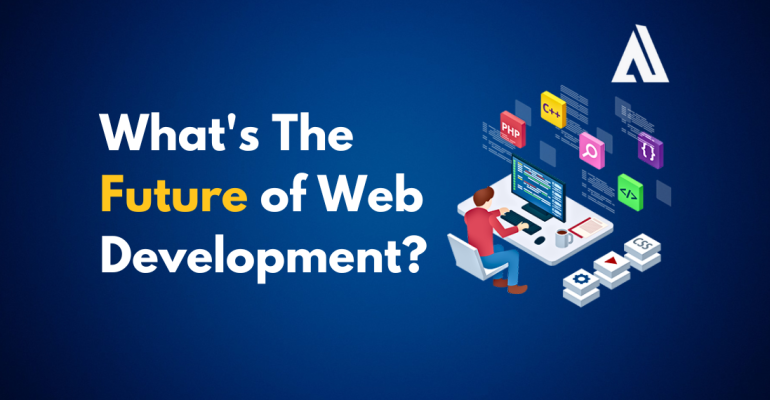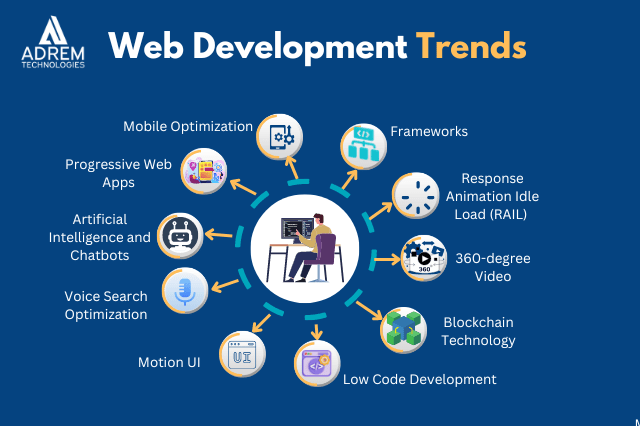What’s The Future of Web Development?

What’s The Future of Web Development?
Web development is an ever-evolving industry with numerous advancements in recent years. This is in response to the exponential growth of websites and the increasing reliance of businesses on online sales via apps and websites, as opposed to brick-and-mortar stores. To remain competitive in this rapidly changing digital market, staying abreast of future web development trends and incorporating innovative ideas into your website is essential.
In today’s rapidly evolving digital landscape, businesses need to stay ahead of the curve to remain competitive. This means developing visually appealing websites equipped with the latest features and functionalities. To achieve this, web developers must constantly develop innovative ideas and stay up-to-date with the newest web development trends.
Following thorough research, we have compiled 10 futuristic trends expected to be the future of web development for the next five years.
Web Development Trends
 1. Mobile Optimization
1. Mobile Optimization
The increasing use of mobile devices for internet access has made mobile optimization a crucial aspect of web development. With the rise of responsive web design, websites can now be easily accessed across various devices and platforms, making it easier for users to browse and engage with them.
As mobile users grow, businesses need to ensure their website is mobile-friendly and optimized for the best user experience. Search engines like Google prioritize mobile-friendly websites, and having a mobile-responsive website can help improve search engine rankings, resulting in more traffic and better visibility.
Therefore, web developers must prioritize mobile optimization and incorporate it into their development strategies to cater to the increasing demand for mobile browsing. This trend will continue in the future as more and more people rely on mobile devices for their internet needs.
2. Progressive Web Apps
Progressive Web Apps (PWAs) have become a game changer in web development. PWAs combine the best of both worlds – the accessibility of a website and the user experience of a mobile app. With PWAs, web developers are creating fast, reliable, and engaging web experiences that can be accessed on any device, anywhere, even with a poor internet connection.
The offline capability of PWAs enables users to access content even when they are not connected to the internet. This feature allows users to continue browsing or using the app without interruption, providing a seamless user experience.
Additionally, PWAs can send push notifications to users, allowing businesses to stay connected with their customers in real time and keep them engaged with the app or website.
As the use of PWAs continues to grow, web development is moving towards creating more immersive, interactive, and engaging web experiences. PWAs are becoming more popular as they provide a better user experience, faster load times, and a more cost-effective way of developing a mobile app-like experience without needing a separate mobile app.
Therefore, it is expected that PWAs will continue to be a major trend in web development for the foreseeable future.
3. Artificial Intelligence and Chatbots
Artificial Intelligence (AI) and Chatbots are revolutionizing how businesses interact with customers. With the help of AI, websites can personalize the user experience and provide intelligent recommendations to users, which can help them make better decisions, discover new products, and engage with content that is most relevant to them.
Chatbots are also becoming more prevalent, allowing businesses to provide 24/7 customer service and support. They can handle a wide range of customer inquiries, from simple questions about product availability to complex technical issues.
Read More: Why Is Responsive Design Important for Websites?
4. Voice Search Optimization
With the widespread adoption of smart devices and virtual assistants like Siri, Alexa, and Google Assistant, voice search has become increasingly popular among users. Instead of typing their queries, people now use their voices to ask questions and search for information online. As a result, voice search optimization has become crucial for websites to ensure that they are visible and accessible to users who prefer this mode of search.
5. Motion UI
Motion UI is a design technique that adds motion and animation to a website or application to enhance the user experience. It uses various visual effects such as transitions, scrolling effects, hover effects, and animations to create a more engaging and interactive interface. By incorporating Motion UI, websites can differentiate themselves from their competition and provide a more immersive experience for users.
One of the main benefits of using Motion UI is that it helps to guide users through a website or application. Animations and transitions can draw attention to important elements and provide feedback to users as they interact with the interface.
Motion UI can also create a sense of continuity between different pages and sections of a website. Transitions and animations can transition between pages smoothly and create a seamless user experience. This can be particularly important for websites with a lot of content, as it can help users navigate the website more easily and find the information they are looking for.
6. Low Code Development
Low code development is a trend that is gaining momentum in the software development industry. This approach allows developers to build applications with minimal coding knowledge and expertise. Instead of writing code from scratch, low code development relies on visual interfaces, drag-and-drop tools, and pre-built modules to create applications quickly and easily.
With this approach, developers can create applications faster than traditional coding methods. On the other hand, low code development reduces the need for expensive developers and can significantly reduce development costs. This makes it an attractive option for businesses with limited budgets.
With low code development, changes can be made quickly and easily, enabling businesses to respond to changing market conditions or customer needs more rapidly.
7. Blockchain Technology
Blockchain technology is transforming numerous industries, including finance, supply chain management, and healthcare. However, it is also revolutionizing the web development industry. Blockchain technology creates decentralized applications, or dApps, that provide a more secure and transparent user experience.
Blockchain technology has the potential to revolutionize business processes through the implementation of smart contracts. By leveraging blockchain, smart contracts enable the automation and streamlining of various business operations, including payment processing, supply chain management, and legal contracts. These innovative contracts eliminate the need for intermediaries, enhance security, and facilitate trust and transparency in transactions.
8. 360-degree Video
360-degree video is a new technology that allows viewers to experience a fully immersive video experience by providing a complete view of the environment in all directions. Unlike traditional videos that provide a fixed point of view, 360-degree videos allow viewers to explore the video scene by panning and tilting their viewing angle, creating an engaging and interactive experience.
The technology behind the 360-degree video is made possible by using multiple cameras to capture the entire environment, which is then stitched together using software to create a seamless 360-degree view. This technology is particularly useful in industries such as travel, real estate, and education, where immersive experiences can help to showcase destinations, properties, and learning environments.
360-degree videos can also be used for virtual reality (VR) experiences. Viewers can fully immerse themselves in the 360-degree video using a VR headset, creating a more engaging and interactive experience.
9. Response Animation Idle Load (RAIL)
RAIL is a performance measurement framework developed by Google for web applications. It is designed to provide a standardized way to measure and optimize the performance of web applications by breaking down the user experience into four key metrics: Response, Animation, Idle, and Load.
Response: This metric measures the time it takes for the application to respond to user input, such as clicking a button or entering text in a form.
Animation: This metric measures the smoothness of animations and transitions in the application.
Idle: This metric measures the amount of time the application is idle, meaning there is no user interaction or animation.
Load: This metric measures the time it takes for the application to load and become fully interactive.
By breaking down the user experience into these four metrics, RAIL provides developers with a standardized framework for measuring and optimizing the performance of web applications. This can help to improve the user experience, increase engagement, and reduce bounce rates.
To optimize the performance of web applications using RAIL, developers need to focus on improving each of the four metrics. This can involve optimizing server response times, reducing the size of images and other media, using efficient animations and transitions, and minimizing the use of heavy JavaScript libraries.
10. Frameworks
A good framework can be essential for developing high-quality web applications. Frameworks provide tools and libraries to help developers build applications more efficiently and effectively while ensuring a consistent and reliable development experience.
As new technologies and trends emerge, developers may need to adapt their frameworks or adopt new ones to stay competitive and deliver the best possible user experiences.
Final Thoughts
The future of web development is constantly evolving and driven by advancements in technology and changing user preferences. Web developers must adapt and incorporate the new tools into their development practices to deliver compelling and innovative user experiences.
Furthermore, web developers must continue to create responsive, mobile-friendly websites and applications that meet users’ needs across various devices. Additionally, the importance of accessibility and inclusive design will continue to grow as more users expect websites and applications that can be used by everyone, regardless of ability.
Ultimately, the future of web development is exciting and full of possibilities, and those who can embrace change and stay up-to-date on the latest trends and technologies will be best positioned for success.
Contact Adrem Technologies for the best web development services to help your business. So, please write to us at info@localhost and get the best services.

